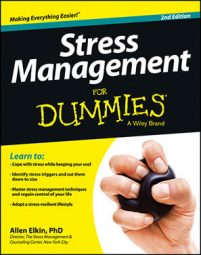1. Manage your stressors
The events that trigger your stress can range from the trivial to the dramatic. They can be very minor — a hassle such as a broken shoelace, a crowded subway, or the world’s slowest check-out line. They can be more important — losing your wallet, hearing sharp words from your boss, or getting a bad haircut a week before your wedding.The list of more serious stressors can be even more dramatic — a divorce, a serious illness, the loss of a job, or the loss of a loved one. The number of potential stressors is endless.
Changing your “A” means altering, minimizing, or eliminating your potential stressors. Following are some examples of what this may look like:
| Potential Stressor | Modified Stressor |
|---|---|
| A crowded commute | Leaving home earlier or later |
| Constant lateness | Learning time-management skills |
| Conflict with relatives | Spending less time with them |
| Anger about your golf game | Taking some golf lessons |
| A cluttered home | Becoming better organized |
| Dissatisfaction with your job | Looking for another job |
| High credit-card bills | Spending less |
| Missed deadlines | Starting projects sooner |
| Angst about the subway | Taking the bus |
You might be saying, “Give me a break! What planet does this guy live on? I can’t quit my job! I have to see my annoying relatives!” And in many cases you’re right. Often you can’t change the world or even what goes on in your own house. You want to change what other people think or do? Good luck!
But you can sometimes minimize or even eliminate a potential stressor. This ability is strengthened if you have the relevant skills. Changing your world isn’t always possible, but when it is, it’s often the fastest route to stress relief.
2. Change your thoughts
Even if you can’t significantly change the situations and events that are triggering your stress, you can change the way you perceive them. What happens at “B” — your beliefs, thoughts, perceptions, and interpretations — is critical in determining how much stress you feel. Whenever you perceive a situation or event as overwhelming or beyond your control, or whenever you think you can’t cope, you experience stress.You may find that much, if not most, of your stress is self-induced, and you can learn to see things differently. So, if you’re waiting in a long line, perhaps you’re thinking, “I just can’t stand this! I hate waiting! Why can’t they figure out a better way of doing this? I hate lines! I hate lines! I hate lines!”
Chances are, you’re creating more than a little stress for yourself. On the other hand, if you’re thinking, “Perfect! Now I have time to read these fascinating articles on alien babies and celebrity cellulite in the National Tattler,” you’re feeling much less stress. Your thinking plays a larger role than you may believe in creating your stress.

